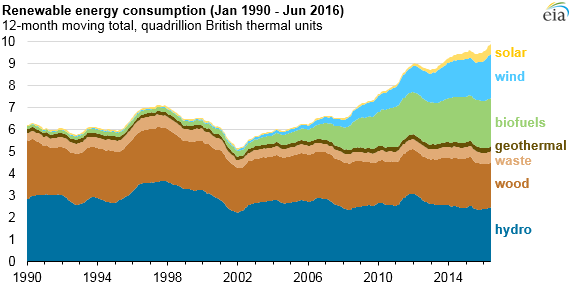466
In the US, CO2 emissions reached the level of 1991
CO2 emissions in the US reached 2,530 million tons for the first half of 2016. It was the lowest level of emissions since 1991 because of the mild weather and changes in the use of different fuels for electricity contributed to the decrease in energy due to emission.
The U.S. Agency for energy information (EIA) in its report, "Short term energy Outlook" predicts that the energy due to CO2 emissions will be reduced to 5,179 million tons in 2016, which is the lowest annual figure since 1992.

Mild weather
In the first half of 2016, the U.S. had the fewest number of days, that required additional heating of buildings since 1949 ( the year from which statistics are kept). Warmer weather in the winter months reduced the need for use of such fuels for heating as natural gas, Akishina oil and electricity.
In General, the total energy consumption for basic needs was 2% lower compared to the first half of 2015. Reducing energy consumption was the most significant in the residential sector, energy consumption and energy costs for basic needs by 9.43%.
Changes in fuel consumption escapemojo
The consumption of coal and natural gas decreased in comparison with the first half of 2015. The decrease in coal consumption was more significant, despite the fact that coal combustion releases more carbon emissions than natural gas.
Coal consumption decreased by 18% and natural gas by 1%. Those declines more than offset a 1% increase in total oil consumption, which grew during this period, due to lower prices for this type of fuel.

The increase in the consumption of renewable energy
Consumption of renewable energy which do not produce hydrocarbon emissions, there has been an increase of 9% over the first half of 2016, compared to the same period in 2015. Wind energy, which demonstrated the highest pererost use as fuels in 2015, 50% of this increase. Hydropower accounted for 35 % of the increase in consumption of renewable energy. And another 13% was achieved by solar energy, the consumption of which is projected to be greatest in 2016.
materials cleantechnica.com
Source: cleantechnica.com
The U.S. Agency for energy information (EIA) in its report, "Short term energy Outlook" predicts that the energy due to CO2 emissions will be reduced to 5,179 million tons in 2016, which is the lowest annual figure since 1992.

Mild weather
In the first half of 2016, the U.S. had the fewest number of days, that required additional heating of buildings since 1949 ( the year from which statistics are kept). Warmer weather in the winter months reduced the need for use of such fuels for heating as natural gas, Akishina oil and electricity.
In General, the total energy consumption for basic needs was 2% lower compared to the first half of 2015. Reducing energy consumption was the most significant in the residential sector, energy consumption and energy costs for basic needs by 9.43%.
Changes in fuel consumption escapemojo
The consumption of coal and natural gas decreased in comparison with the first half of 2015. The decrease in coal consumption was more significant, despite the fact that coal combustion releases more carbon emissions than natural gas.
Coal consumption decreased by 18% and natural gas by 1%. Those declines more than offset a 1% increase in total oil consumption, which grew during this period, due to lower prices for this type of fuel.

The increase in the consumption of renewable energy
Consumption of renewable energy which do not produce hydrocarbon emissions, there has been an increase of 9% over the first half of 2016, compared to the same period in 2015. Wind energy, which demonstrated the highest pererost use as fuels in 2015, 50% of this increase. Hydropower accounted for 35 % of the increase in consumption of renewable energy. And another 13% was achieved by solar energy, the consumption of which is projected to be greatest in 2016.
materials cleantechnica.com
Source: cleantechnica.com
Love acquired the status of rarity and scarcity...
Win-win color for the kitchen interior of your dreams























